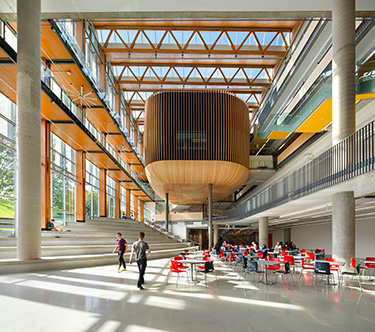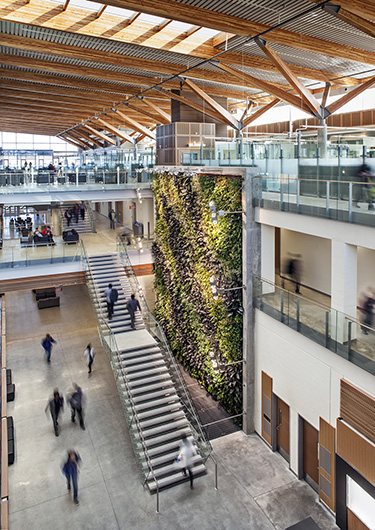|
Subscribe / Renew |
|
|
Contact Us |
|
| ► Subscribe to our Free Weekly Newsletter | |
| home | Welcome, sign in or click here to subscribe. | login |
Real Estate
| |
 |
July 30, 2020
Design, science and the brain
B+H Architects

Olt
|
While our current work-from-home circumstances have some benefits, such as greater personal flexibility and the elimination of stressful commutes, many of us are also experiencing first-hand the impact of a limited, unvaried environment on our physical and mental health. We are, effectively, subjects in a global experiment in how environments impact human health — and the evidence is mounting.
Physio-sensory connection
In 2019, visitors to Milan Design Week received a physio-sensory wristband on entry to the exhibition, “A Space for Being.” The band was the brainchild of Google’s Ivy Ross and Susan Magsamen, founder of the International Arts + Mind Lab at Johns Hopkins University. It was designed to measure how visual aesthetic experiences impact our health and wellbeing. The data collected informed a life-changing new branch of science called neuroaesthetics, the study of how sensory environmental input impacts human physiology and psychology.
In 1999, British neurobiologist Semir Zeki began using non-invasive brain imaging techniques to understand how and why humans respond to the arts. As sensor technology becomes more accessible (and wearable) this new branch in the study of brain science is focusing on how aesthetic experiences such as exposure to architecture, visual design, music and dance register in our brain and affect our body’s biological and emotional responses. The findings are compelling and have significant implications for the design of our built environments.
Patterns and movement
Recent physiological research demonstrated direct correlations between the lower stress indicators in the body and increased tactile experience with natural materials, visual access to nature and non-rhythmic sensory stimuli, such as hearing the wind or observing changing light patterns.
Natural materials
In recent Japanese studies, the touch and sight of wood was found to induce significant physiological and psychological relaxation, as compared to control materials of tile, steel, resin and marble.
Indoor greenery
Exposure to plants has not only proven to lower the release of oxyhemoglobin, a stress protein that affects the brain, but their intentional use in interior design can also mitigate the indoor air migration of aerosols. For example, foliage between work areas create micro-eddies and can limit the flow of air contaminants.
Architectural bodybuilding
Innovation in architecture occurs incrementally by subtle or not-so-subtle developments in scientific discoveries, technological breakthroughs, pandemics and socio-political reform. The growing findings from the study of neuroaesthetics, coupled with evidence from our personal experiences in quarantine is contributing to a far greater understanding of the direct link between environmental and human health.
B+H is responding with increased urgency to better comprehend the link between natural systems and human response mechanisms. We are researching novel ways in which a building’s structural elements and design language can play a pivotal role in enhancing wellness. Drawing deeply on biophilic principles, we are exploring the ways in which natural materials, access to non-rhythmic sensory stimuli and organic shapes can apply across all scales, from the position of a body in a room to the planning of entire communities and cities.
Access to natural greenery
Exposure to plants, natural views and nature imagery plays a positive role in recovery and pain management inside care facilities, as demonstrated in Roger Ulrich’s groundbreaking 1984 study. Recent research builds on these findings and suggests views of natural surroundings may benefit men and women differently. Men with obstructed views of nature demonstrated a decline in mental health, while women with obstructed views appeared to show a greater decline in physical health. The bottom line is that views of nature measurably boost health.
Improved focus
Earlier this year, Oshin Vartanian, a psychologist at the University of Toronto, documented that while coherence and fascination were well-established dimensions in response to architecture, hominess emerged as a new dimension. Neuroscientists like Colin Ellard are using physical environments and immersive virtual reality to test mood, concentration and stress levels of people in varied surroundings.
Positive emotion
Ed Connor of Johns Hopkins University explored how specific shapes — such as the smooth curves in the work of French-German sculptor Jean Arp — create pleasant emotional responses. The shape of a space, a building, a street or a skyline can affect us. Rectilinear forms increase stress; sinuous forms reduce it.
Vartanian conducted a functional MRI study that showcased photos of interior design projects with either a curvy or linear aesthetic. The results revealed that participants overwhelmingly favored spaces with curved furniture, fixtures and floor patterns over their angular counterparts. Most strikingly, Vartanian’s brain scans discovered that curved designs led to a burst of activity in the anterior cingulate cortex — a cognitive area of the brain that triggers an emotional reaction — whereas interior spaces bearing sharp corners and straight lines did not. In short, we are wired for an emotional connection to rounded forms. The form does matter.
Promoting human health
This latest research provides evidence that our immediate surroundings affect our brain functions beyond our consciousness. As architects and designers of the built environment, we have a responsibility to use this information to design better performing spaces that promote and support human health. Neuraesthetically informed design can lower breathing rates, blood pressure, pain and anxiety.
In the past it has been hard to articulate the emotional and psychological impact of a positive aesthetic experience, but by combining the science with accessible sensor technology we have the gift of a new language. Technology can help us know ourselves better and the essential revelation is that the way we consciously think about space is not necessarily in line with how our bodies react to it. The body is a vast sensory system and its responses may well be different from the bias of our rational mind.
The 2019 Milan Design Week exhibition showed that design affects our bodies in an immediate, direct and impactful way. People have agency over the environments they choose to inhabit and the global quarantine experiment has provided us all with a heightened awareness of the impact of space on our mental and physical health. Architectural solutions that evolve at the intersection of neuroscience, arts and technology will contribute to healthier communities and promote social cohesion, engagement and wellbeing.
Matthias Olt is the design director with B+H Architects.
Other Stories:
- Sustainable satellites: Saviors of our cities?
- The evolution of urban development on First Hill
- Life science thrives in urban hubs
- Bold architecture blends with nature in the city
- A radical rebalancing of the urban environment
- Landscape architecture in the time of COVID-19
- Seattle’s march toward legacy city
- The coming evolution of cities and public spaces
- Designing for a holistic community experience




